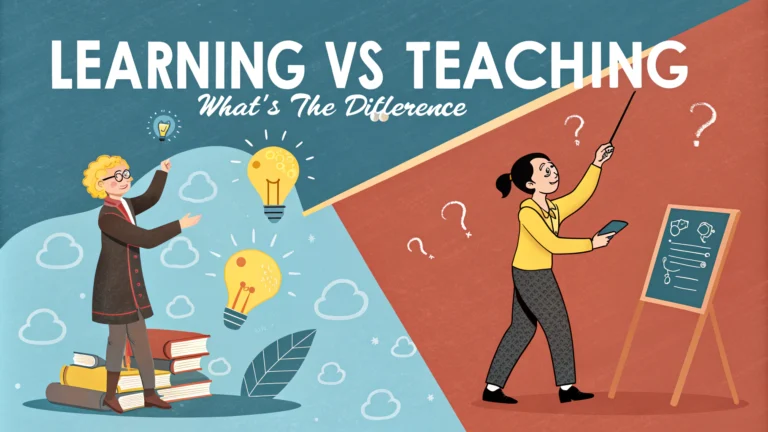The relationship between learning and teaching represents two sides of the educational process. While closely connected, these processes require different skills, approaches, and mindsets.
Learning focuses on **knowledge acquisition** and **skill development**, while teaching involves **knowledge transfer** and **facilitating understanding**. Understanding these differences helps both educators and students improve their respective roles in education.
Key Differences Between Learning and Teaching
- **Direction**: Learning flows inward (receiving), teaching flows outward (giving)
- **Role**: Learner processes information, teacher facilitates understanding
- **Focus**: Learning emphasizes absorption, teaching emphasizes explanation
- **Responsibility**: Learning requires self-motivation, teaching requires guiding others
Essential Learning Strategies for Better Knowledge Retention
- **Active recall** through practice tests
- **Spaced repetition** for long-term memory
- **Mind mapping** for concept connections
- **Teaching others** to reinforce understanding
“The best teachers are those who show you where to look but don’t tell you what to see.” – Alexandra K. Trenfor
Effective Teaching Methods and Approaches
| Teaching Style | Best Used For |
|---|---|
| Demonstrative | Practical skills |
| Interactive | Complex concepts |
| Inquiry-based | Critical thinking |
Measuring Learning Progress and Outcomes
**Assessment methods** and **progress tracking** help both teachers and students understand knowledge retention. Regular evaluation allows for adjustments in learning approaches and teaching strategies.
- **Self-assessment** through learning journals
- **Peer reviews** for collaborative feedback
- **Performance metrics** using rubrics
- **Portfolio development** to track growth
Technology Integration in Learning and Teaching
**Digital tools** enhance both teaching delivery and learning experiences. The right mix of technology supports different learning styles while making education more accessible.
| Tool Type | Learning Benefits |
|---|---|
| Learning Management Systems | Organization and tracking |
| Interactive Apps | Engagement and practice |
| Video Platforms | Visual learning and review |
Creating Supportive Learning Environments
**Physical and virtual spaces** impact learning outcomes significantly. Setting up the right environment helps maintain focus and encourages active participation.
- **Organized workspace** with minimal distractions
- **Proper lighting** and temperature control
- **Accessible resources** and materials
- **Collaborative spaces** for group work
“Education is not the filling of a pail, but the lighting of a fire.” – W.B. Yeats
Applying Learning and Teaching Principles
Success in education comes from understanding and applying core principles consistently. Regular practice and adaptation of these methods leads to better outcomes for both teachers and learners.
- Start with clear learning objectives
- Use feedback to improve methods
- Adapt strategies based on results
- Maintain open communication channels
Remember that learning and teaching are ongoing processes that require patience, dedication, and continuous improvement from all participants.
Frequently Asked Questions About Learning vs Teaching
Basic Concept FAQs
Q: What is the fundamental difference between learning and teaching?
A: Learning is the process of acquiring knowledge and skills through study, experience, or instruction, while teaching is the act of helping others acquire knowledge and skills through guidance and instruction.
Q: Can someone be good at learning but poor at teaching?
A: Yes. Learning and teaching require different skill sets. Strong learners may not naturally possess the communication and instructional skills needed for effective teaching.
Learning Process FAQs
Q: What are the main learning styles?
A: The primary learning styles include:
- Visual (learning through seeing)
- Auditory (learning through hearing)
- Kinesthetic (learning through doing)
- Reading/Writing
Q: Why do some people learn faster than others?
A: Learning speed varies due to:
- Individual cognitive processing
- Prior knowledge and experience
- Learning environment
- Motivation levels
- Learning style match
Teaching Methodology FAQs
Q: What makes an effective teacher?
A: Effective teachers typically possess:
- Strong subject knowledge
- Clear communication skills
- Adaptability to student needs
- Patience and empathy
- Classroom management abilities
Q: How does online learning differ from traditional teaching methods?
A: Online learning typically involves more self-paced study, digital tools, virtual interaction, and requires stronger self-motivation compared to traditional classroom teaching.
Long-tail Keyword FAQs
Q: What are the best teaching methods for visual learners in mathematics?
A: Visual learners in mathematics benefit from diagrams, graphs, video demonstrations, color coding, and visual problem-solving techniques.
Q: How can teachers improve student engagement in virtual classrooms?
A: Teachers can improve virtual engagement through interactive polls, breakout rooms, multimedia content, regular feedback, and collaborative online activities.
Q: Which learning techniques work best for adult professionals?
A: Adult professionals typically benefit from:
- Problem-based learning
- Real-world applications
- Self-directed study
- Experiential learning
- Peer discussion groups
Q: What role does technology play in modern teaching methods?
A: Technology in modern teaching includes:
- Learning management systems
- Interactive software
- Virtual reality applications
- Online assessment tools
- Digital collaboration platforms
Q: How can teachers accommodate different learning speeds in one classroom?
A: Teachers can accommodate varied learning speeds through differentiated instruction, flexible grouping, personalized assignments, supplementary materials, and adaptive learning technologies.



















